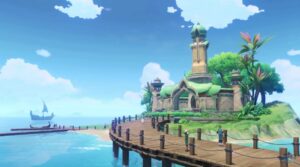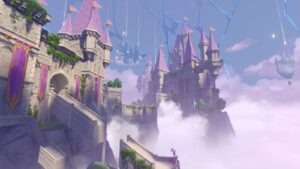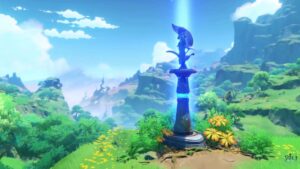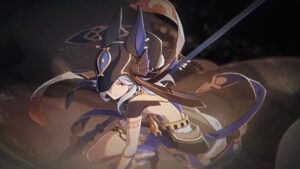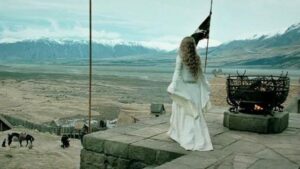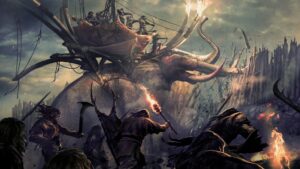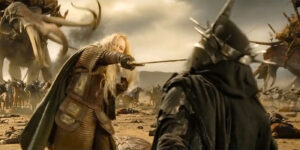We’ll probably never know if MiHoYo, anticipating backlash to the first official look at the three new playable characters coming to Genshin Impact in Version 3.0, revealed the identities of the game’s mysterious villains, the eleven Fatui Harbingers, as a distraction – something to keep the fans content, by feeding them hollow promises of more varied and interesting character designs in the far-off future while in the here and now, the game developers couldn’t even be bothered to experiment with different skin-tones for new playable characters, much less designing entirely new character models. But there can be no doubt that, whether by design or by coincidence, the distraction worked.

In a new Teyvat Chapter Interlude Teaser titled “A Winter Night’s Lazzo”, nine of the ten remaining Fatui Harbingers gather in Snezhnaya to mourn the recent loss of their troupe’s eleventh member, La Signora, and to bury what little remains of her. But the solemn evening quickly devolves into chaos as the Harbingers begin hurling insults at each other from opposite sides of La Signora’s coffin, until only an intervention by the mysterious Pierro, first and foremost of the Harbingers, can put an end to their little lazzo.
For those unfamiliar with the now somewhat archaic Italian term, a lazzo is any short comedic routine in the Commedia dell’arte, typically improvised by its performers to smooth transitions between scenes or recapture an audience’s waning interest. The Commedia dell’arte were comedic or satirical plays performed by wandering troupes of actors that originated in Italy sometime in the 16th Century and later became popular across southern Europe (until they were outlawed by Napoleon in 1797) – these plays always involved the same stock characters with exaggerated personality traits, outlandish outfits and grotesque masks, but the plots would change around them depending on the audience a troupe was catering to at any given moment.
For reasons that remain unclear, the Harbingers have each adopted or been assigned the name of a stock character from the Commedia dell’arte, and they each share a handful of similarities with their Commedia counterpart – although there are key differences worth mentioning as we work our way through the Harbingers in order of appearance. But first, a little background on how the Harbingers came to be: don’t be impatient, this part’s not very long, anyway.
The only thing we can say with absolute certainty regarding the Harbingers’ origins is that they were formed shortly after the Cataclysm (the destruction of the nation of Khaenri’ah and the systematic genocide of its people by Celestia, or by Archons responding to Celestia), and that their founding member was a survivor of the Cataclysm known only by the Commedia alias he took when he first established the Harbingers – Pierro, the Jester. In the roughly five-hundred years since the Cataclysm occurred, Pierro has recruited ten new members (that we know of), and each one seems to harbor a grudge against a particular god, or just against gods in general.
Rosalyne, who became known as La Signora after joining the Harbingers, hated the Anemo Archon Barbatos because he was nowhere to be found when she prayed to him for help during the Cataclysm. Kunikuzushi, or Scaramouche as he was later known, was designed to be a container for the Raiden Shogun’s Electro Gnosis – but she deemed him unfit for the task and discarded him, leaving him to wander the earth aimlessly for centuries until he found the Harbingers. As for Ajax, later Tartaglia…well, I don’t really know what his deal was, but after falling into the Abyss at the age of fourteen and having to battle his way out I wouldn’t blame him for hating the gods just because.

But gods can hold grudges too. At some point, Pierro aligned himself with the nameless Cryo Archon of Snezhnaya, who – despite being a god herself – was also angry at Celestia. We still don’t know why (although it’s been postulated that perhaps the Cryo Archon regrets the role she played in Khaenri’ah’s destruction, as she seems to have been a gentle goddess before the Cataclysm) and we don’t know whether Pierro is actually loyal to her or whether he’s been exploiting her guilt to get what he wants out of the arrangement. It’s telling that Pierro is playing chess with the Gnoses collected from the Anemo and Geo Archons at the beginning of the teaser, indicating that he hasn’t handed them over to the Cryo Archon despite taking them in her name.
Speaking of chess, I know for a fact that I was not the only one who gasped out loud when I saw the Anemo and Geo Gnoses on Pierro’s chessboard, standing in for the white queen and remaining white rook, respectively. The Genshin Impact “chess theory”, which has been around for a while now, has always hinged on the idea that the Archons correspond to specific chess pieces represented by the design of their Gnoses, but this outright confirms it: the Archons – or at the very least their Gnoses – are the pieces that Celestia has been using to protect themselves, but based on the layout of this board time is running out for them and the Fatui would have to make a grievous error for the gods to take back control of the game.
Mind you, we don’t know for sure that this chessboard represents the current state of affairs in Teyvat or if this is just one of many scenarios envisioned by Pierro for how the war could proceed, but the fallen black pawn certainly seems to stands in for La Signora, which means the white knight that took it off the board presumably represents Raiden Shogun, the Electro Archon whose Gnosis is still in the hands of the rogue Harbinger, Scaramouche. Pierro, however, is playing as white (I assume he’s gauging what his enemy will do next), and white is losing badly – at least according to people more knowledgeable about chess than me. I’m starting to regret having never finished The Queen’s Gambit…
Speaking of queens, which piece on this board represents the Cryo Archon, and why doesn’t Pierro have her Gnosis in his possession? That’s very interesting to me. The Cryo Archon’s Gnosis should be the easiest for Pierro to obtain, but if he doesn’t have it does that mean she’s still somewhat distrustful of him even now? And who here represents the Traveler, and their twin sibling? If Celestia is white, what happened to both of their bishops, their other knight, and their other rook – or is Pierro leaving those pieces off the board because he hasn’t obtained the equivalent Gnoses yet? Is Pierro himself the black king, black queen, or neither? Are we overanalyzing all of this?
Anyway…I mentioned that La Signora is the fallen black pawn in this scenario, and that’s largely because a red moth symbolizing her lands on the pawn. Later, near the very end of the teaser, it alights on the stone lid of her coffin and bursts into flame. Because this is Genshin Impact we’re talking about here, we can’t be 100% certain that La Signora is dead. I mean, she’s definitely dead, but if a little bit of her consciousness was able to stay alive in a moth long enough to fly all the way from Inazuma to Snezhnaya, there’s no saying that other moths carrying fragments of her being couldn’t have escaped to various far-flung corners of Teyvat, where they’re just waiting for us to piece them back together and reconstruct Rosalyne.

But for the moment, she’s dead – and for her sake, I hope that her little moth fragments can’t hear what her so-called comrades are saying about her over her literal dead body, because it’s appalling. The only Harbinger in mourning is Columbina, the Damselette, a young woman with what looks like a biblically-accurate angel strapped to the back of her head. Columbina (or Colombina, which translates to “little dove” in Italian) is arguably the most prominent of the female characters in the Commedia dell’arte due to the frequency with which she appears and her close relationships with other characters – she is Pierro’s adulterous wife, Arlecchino’s flighty lover or best friend, the Innamorata’s gossipy confidante and the object of Pantalone’s desires. It makes sense that her Fatui counterpart would be the only character close enough to La Signora while she was alive to even shed a tear for her now that she’s dead.
By contrast, the Harbinger Pulcinella declares loudly that he thinks half a day is all the time needed for Snezhnaya’s citizens to mourn La Signora before getting back to work, with a callousness in his voice that surprises even Pantalone and Arlecchino, who are both equally appalling in their own ways. But if you know anything about the Pulcinella of the Commedia dell’arte, you probably know this much: that he cares about no one but himself. He takes no course of action that is not guaranteed to benefit him, and even when he misjudges a situation or is deceived and led into a trap by his enemies, he still somehow manages to come out on top in the end because he is extraordinarily lucky. The Fatui’s Pulcinella is referred to as “Mayor”, and I have no doubt that he weaseled his way into a position of power by the same means his Commedia counterpart would employ – bribery and deceit.
Before we move on, I want to take a moment to appreciate Pulcinella’s nose. Genshin Impact‘s characters are typically designed in such a way that their noses are almost invisible, but Pulcinella’s not only dominates his face, it dominates the entire space directly in front of him – it’s extremely long and pointy, extending far out beyond his bushy white mustache. We can safely assume this is a reference to the rooster, the bird from which Pulcinella’s name is supposedly derived, and to the long-nosed mask worn by Pulcinella in the Commedia. It hasn’t made him very popular with the Genshin Impact community, sadly, but if there’s any justice in this world, Pulcinella will one day be a terrific five-star unit – just you wait.
If Pulcinella is remarkably alike to his Commedia counterpart, however, than Pantalone is surely the furthest removed. Gone is the skinny old man dressed in tight, brightly-colored trousers and a comically large codpiece, his face hidden behind a half-mask with exaggerated wrinkles – in his place now stands a tall, broad-shouldered, bespectacled man of indeterminate age sporting a tumbling mane of luxurious raven hair and a permanent smirk. It’s only when he opens his mouth that he betrays his true identity, because just like the Pantalone of the Commedia dell’arte, this Harbinger can’t string together a sentence without slipping in a boast about his wealth.
There’s still a difference in their delivery, because whereas Commedia Pantalone is deeply insecure about himself and therefore boasts loudly to ensure his listeners know he’s still richer than they’ll ever be, Genshin Impact‘s Pantalone seems to be content, and thus his boasts are so subtle they might fly over a listener’s head entirely, only to circle back around later like one of those insults that our brains don’t register as insults at first. In short, he’s everything that Commedia Pantalone desperately wishes he were, but could never be.
I have a sneaking suspicion we’ll meet Pantalone in-person shortly before Version 4.0, probably as part of an Event Quest involving Yelan or in a second chapter of Yelan’s Story Quest, Umbrabilis Orchis. The two characters have already been established as archenemies, with Yelan’s character profile revealing that the Harbinger once stole an heirloom belonging to her family – so as payback she snuck into a Fatui camp, stole a priceless fur-coat that Pantalone had intended to present to the Cryo Archon as a gift, tailored it to fit her, and now wears it around all the time. I also firmly believe that every Harbinger has a nemesis amongst the cast of playable characters who will one day either face them in battle or convince them to turn their back on the Fatui.

And on that note, let’s move on to Arlecchino – because in my research for this post, I came across this theory by Reddit user u/catcul7 linking the Fatui Harbinger to the character of Eula, and I haven’t been able to get it out of my mind since. I’d call it a coincidence that the two women look remarkably similar if not for the fact that Eula’s family, the Lawrence Clan of Mondstadt, is known to have ties to the Fatui and at one point was even plotting to overthrow the Acting Grand Master of the Knights of Favonius with their help. Unfortunately, it’s been a while since we last had the chance to sit down with Eula and chat about her family, so here’s hoping she pops up randomly in an Event Quest sometime soon.
Arlecchino in the Commedia is a little bit of everything rolled into one character and stuffed in a checkered costume. He can be the trickster, the fool, the romantic lead, the master of physical comedy – and he can be all of these things separately, or simultaneously, depending on what will hold the audience’s interest at any given moment. The person playing Arlecchino needed to be able to quickly determine what that might be, and to improvise accordingly – sometimes even requiring the entire play to change course and follow after him. He is an agent of chaos, and there’s really no telling what he’ll do because even he doesn’t always know for sure.
That said, there’s only so many different routes you can take a character after two centuries of Commedia dell’arte performances, and certain patterns in Arlecchino’s behavior began to emerge – he was frequently the rival of Pierro, and the lover of Columbina (among countless other women, but Columbina was always his one true love). With Genshin Impact deliberately casting a woman in the role of Arlecchino, they’re teasing the kind of queer representation that fans have pleaded for in the past and never received, and there’s nothing to suggest this will be any different. Arlecchino and Columbina will have flirty voice-lines about one another, they’ll talk about each other in their birthday messages to us, their character arcs will intertwine and they’ll be inseparable in every event where they’re together…and their relationship will linger in that state of nearly-but-not-quite canon forever.
Next up, we have Tartaglia – but players will have already met him during the Liyue Archon Quest and might even have him in their party already, so I’ll just run through the basics real quick before moving along. Tartaglia is a fairly minor character in the Commedia dell’arte, just as he is the weakest of the Fatui Harbingers in Genshin Impact, and both are subjected to constant ridicule. The similarities end there. Tartaglia in the Commedia is typically a civil servant who stumbles through long speeches and “often will find himself stuck on the most obscene syllable in any given word”. Tartaglia the Harbinger is a friend and ally of the Traveler, but nonetheless remains devoted to the Cryo Archon and is currently hunting Scaramouche with the intention of recovering the Electro Gnosis in her name.
His attempts to capture Scaramouche have proved unsuccessful, and the other Harbingers need no further excuse to pile on the insults, with Sandrone remarking that he is “utterly risible”. Sandrone, typically depicted as a peasant from the Italian city of Modena with wooden puppets for a wife and son, has been reinvented as a small girl who uses Khaenri’ahn Ruin Machines as her playthings and servants, earning her the title of “Marionette” from her fellow Harbingers. Now, we know for a fact that Tartaglia is the youngest of the Harbingers, so despite her childish appearance, Sandrone must be older than him – and there’s a strong chance that even this child we think is Sandrone being carried around in the massive hand of a Ruin Machine (dressed rather handsomely, I must admit, in a top hat and ruffled collar) is actually a puppet speaking with the real Sandrone’s voice.

Who knows, maybe the real Sandrone is one of those Russian nesting dolls – maybe we’ll never find her, we’ll just keep finding dolls inside of dolls inside of dolls inside of yet more dolls, until our minds fracture and reality crumbles around us and we begin to question whether there ever was a Sandrone to begin with, or whether this is all an elaborate prank. I’m just throwing out ideas here, but it could be cool in a trippy, existential-crisis inducing kind of way.
Then we have Il Capitano, the great military strategist responsible for leading the Fatui to their recent victories in…uh, somewhere we obviously haven’t been yet! The Harbinger talks a big talk for someone we’ve never once seen at the frontlines during any of our frequent battles or skirmishes with the Fatui – trust me, I would remember a seven-foot tall man with no visible face behind an iron mask. And what’s up with that, anyway? Is he hiding his face, or the fact that he’s not even in the suit of armor? That would track with what we know about Il Capitano from the Commedia dell’arte, which is that he’s almost always depicted as a coward who pretends to be a decorated war veteran in the hope that women will find him more attractive.
It’s still very early in the game, but I suspect that Capitano will play a significant role in Natlan (so probably around Version 5.0 and onwards), when we meet the Pyro Archon who has modeled her nation around the ideal of War. And until Capitano’s true identity is actually revealed, I’m gonna cling to my headcanon that he’s somehow associated with Natlan because I need Genshin Impact to finally acknowledge that Natlan actually exists. We’re two years into this game and we haven’t even met any NPCs from Natlan. I worry that there’s a correlation between that and the fact that we know of exactly one playable character from Natlan, who happens to be darker-skinned than the majority of the cast…but I’m also steeling myself for the inevitable reveal that the rest of Natlan’s playable characters are either light-skinned or white.
That was a bit of a tangent, but maybe not given that our next character is Il Dottore, and he’s the Harbinger we’re almost sure to meet in Sumeru when Version 3.0 releases just about a month from now. If I ignore everything about Sumeru that infuriates me to no end, like the white playable characters dressed in orientalist parodies of Southwest Asian clothing, I could maybe get excited for those interactions because Il Dottore is a character we’ve been waiting a long time to see (he first appeared in the Genshin Impact manga, albeit in a very different form), and he’s blessed with a phenomenal English voice actor (whose identity has not yet been revealed, as of this writing).
In the Commedia dell’arte, Dottore is a doctor – usually a very bad one, whose methods range from humorous to horrific. But because he went to university (or at least, so he claims), he regards himself as the foremost authority on every subject and often spouts utter nonsense to make himself sound smart. He is the rival of Pantalone, and in stories that revolve around the Lovers these two are usually the fathers of the male and female love interest, respectively. In Genshin Impact, Dottore studied at the prestigious Sumeru Academiya to become a doctor, but only avoided being expelled because he became very good at hiding the evidence of his abhorrent experiments on unwilling human test subjects. Yikes.

Based on an exchange between Columbina and Dottore later in the teaser, where the Damselette asks after one of the Doctor’s other “Segments”, specifically “the Segment in the prime of his life”, it sounds like the Doctor was able to successfully clone his younger self for posterity’s sake. Whichever Segment is actually present at La Signora’s funeral is presumably the most senior of them all, but he clearly has a great deal of faith in his younger self, because as he says to Columbina, he’s assigned him a task; some vague “experiment in blasphemy” that involves a burning tree somewhere. I’m guessing it’s somewhere in Sumeru, because from there we immediately cut to Collei, one of the new playable characters from Sumeru, waking up in a fright after a terrible dream.
Collei, another character introduced in the manga, was one of ll Dottore’s test subjects who narrowly escaped from his laboratory after being pumped full of Archon Residue to see if her body could contain the raw powers of a god. I don’t know whether everything that happened in the manga is still canon (Dottore, for instance, now wears the distinctive one-third mask of his Commedia counterpart, and his hair is longer, wavier, and a slightly paler shade of green than it once was), but I doubt there have been too many changes on that front. Collei is obviously the prime candidate for the role of Dottore’s archenemy, but there’s a strong case to be made for Dottore himself being his own archenemy.
In other words, at least one of Dottore’s younger Segments has probably had a lot of time to think things over and maybe they’ve come to the conclusion that they don’t actually want to be the person they know for a fact they’ll become if they continue down the path they took the first time around. I’m not saying this will definitely happen, but if Dottore is going to be a playable character someday (and he’s rumored to be, as are most of the Harbingers), I just hope people know that his playable version is probably not going to be the one whose hobbies include murdering children. The playable version of Dottore might have contemplated murdering children, but I highly doubt he’ll have gone ahead with it.
The first of the Fatui Harbingers is also the last to step out of the shadows and into the light – but Pierro seems oblivious to the theatricality of his own delayed entrance, and commands his minions to stop playing their parts so he can deliver a booming monologue about seizing authority from the gods and burning away the old world. That’s the thing about Pierro; he’s never in on the joke. In the Commedia, he’s most frequently depicted as a naïve and gentle-natured clown who is hopelessly with Columbina, although she will never notice him. When he tries to help his friends, they dismiss his advice and ignore his warnings. When he tries to take matters into his own hands, accidents ensue and he is shamed and laughed at by his castmates and the audience.
So for this man – whoever he may truly be – to go around calling himself Pierro and embracing the identity of the Jester (although not the outfit), well, that takes either remarkable courage or an equally remarkable lack of self-awareness on his part, and I have a feeling we won’t know which it is until we finally confront the guy…which probably won’t be for several years, but in the meantime I guess we can speculate about what he’s hiding behind that antlered mask that only covers the right half of his face. It’s a variation on the eyepatches that Kaeya and Dainsleif wear over their right eyes, which is notable because all three of these characters are originally from Khaenri’ah and we have reason to believe that their right eyes either contain esoteric secrets or somehow are esoteric secrets in and of themselves.

It’s complicated. But basically, eyes are a big part of Genshin Impact‘s lore, and it’s very rarely a coincidence when two or more characters have similar eyes. There are already theories floating around that Pierro is Kaeya’s father, or Dainsleif’s father, or both their fathers, or perhaps their grandfather, and honestly…all of those sound plausible. It would be one thing if their left eyes weren’t all identical, but they all share ice-blue eyes with diamond-shaped pupils, and I refuse to believe that’s not intentional. The only problem is that even if it is, we still don’t know what it means or why it’s significant (Genshin lore is like that, though).
But now that we’ve made it through all eleven Harbingers (excluding La Signora and Scaramouche, because one’s dead and the other one wasn’t in the teaser so there’s nothing new to say about him), it’s time for you to tell me which of the newly revealed Harbingers is your personal favorite, and when you expect to see them in-person. Feel free to share your own thoughts, theories, and opinions, in the comments below!
